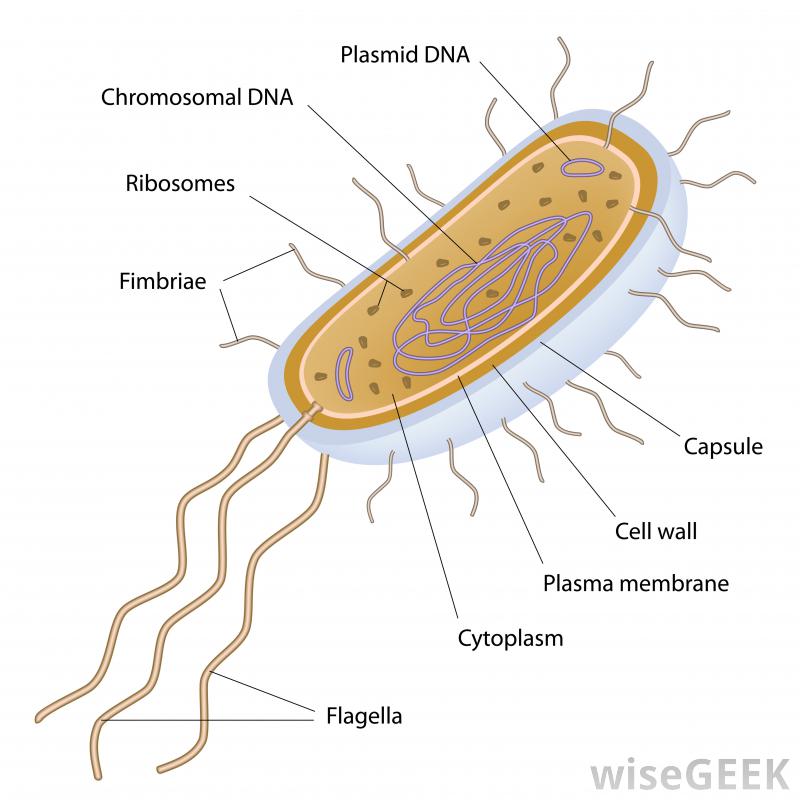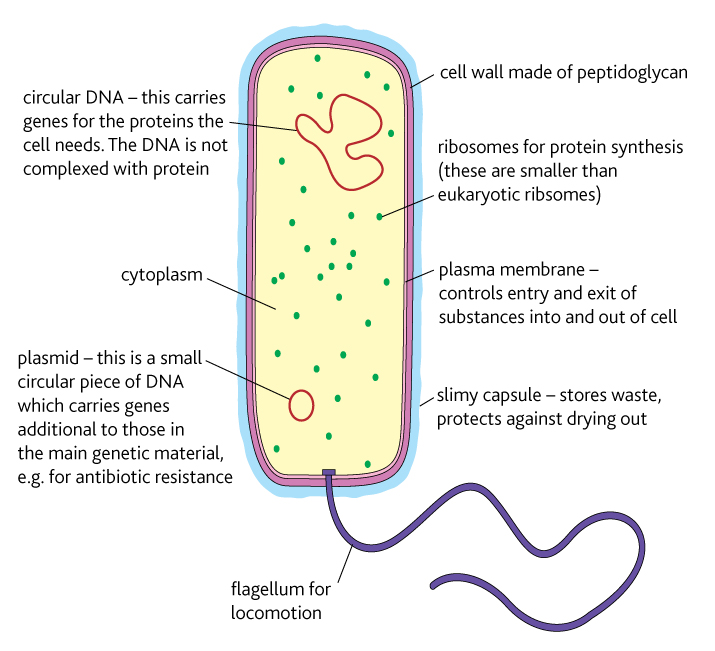
Bacteria Ms A Science Online
Bacterial cells are between about 1 and 10 μm long. And most of them are only 1 to 2 μm in diameter. 1 μm, or micrometre, is 1 000 times smaller than a millimetre.. Bacterial Structure. Click on the numbers to learn more about the parts of a bacterial cell. To the right, the second is an oval-shaped, crusty loaf of bread with a paper.

Bacteria cell anatomy Royalty Free Vector Image
Shape and Arrangement-1 Cocci (s., coccus) - spheres diplococci (s., diplococcus) - pairs streptococci - chains staphylococci - grape-like clusters tetrads - 4 cocci in a square sarcinae - cubic configuration of 8 cocci Shape and Arrangement-2 bacilli (s., bacillus) - rods coccobacilli - very short rods

Innovic Medical Bacterial Cell Structure
A bacterial cell (Fig. 2.5) shows a typical prokaryotic structure. The cytoplasm is enclosed by three layers, the outermost slime or capsule, the middle cell wall and inner cell membrane.

Pin by Magpie on ชีวะ Prokaryotic cell, Eukaryotic cell, Prokaryotic cell model
Prokaryotes are single-celled organisms belonging to the domains Bacteria and Archaea. Prokaryotic cells are much smaller than eukaryotic cells, have no nucleus, and lack organelles. All prokaryotic cells are encased by a cell wall. Many also have a capsule or slime layer made of polysaccharide.

bacterial cell diagram and functions
Definition Bacteria Diagram Ultrastructure of a Bacterial Cell Classification Reproduction Useful Bacteria Harmful Bacteria Today, bacteria are considered as one of the oldest forms of life on earth. Even though most bacteria make us ill, they have a long-term, mutual relationship with humans and are very much important for our survival.

5.E The Cell (Exercises) Biology LibreTexts
bacteria, any of a group of microscopic single-celled organisms that live in enormous numbers in almost every environment on Earth, from deep-sea vents to deep below Earth's surface to the digestive tracts of humans. Bacteria lack a membrane-bound nucleus and other internal structures and are therefore ranked among the unicellular life-forms.

prokaryotic cell bacteria parts
A prokaryote is a simple, single-celled organism that lacks a nucleus and membrane-bound organelles.

What part of the bacteria cell helps it stick to surfaces? Socratic
Bacteria are prokaryotes, lacking well-defined nuclei and membrane-bound organelles, and with chromosomes composed of a single closed DNA circle. They come in many shapes and sizes, from minute spheres, cylinders and spiral threads, to flagellated rods, and filamentous chains.

Bacterial Structure Plantlet
These can rotate or move in a whip-like motion to move the bacterium. Plant and bacterial cell walls provide structure and protection. Only plant cell walls are made from cellulose. The DNA of.

Bacterial Cell Structure and Function
Fungal and protistan cells also have cell walls. While the chief component of bacterial cell walls is peptidoglycan, the major organic molecule in the plant cell wall is cellulose (see structure below), a polysaccharide made up of glucose subunits. Figure 9. Cellulose is a long chain of β-glucose molecules connected by a 1-4 linkage.

Bacterial cell structure and function YouTube
Capsule. A bacterial capsule is a polysaccharide layer that completely envelopes the cell. It is well organized and tightly packed, which explains its resistance to staining under the microscope. The capsule offers protection from a variety of different threats to the cell, such as desiccation, hydrophobic toxic materials (i.e. detergents), and bacterial viruses.

Bacteria Cell Vector Art, Icons, and Graphics for Free Download
Structure of Bacterial Cell (With Diagram) Article Shared by ADVERTISEMENTS: In this article we will discuss about the Structure of Bacterial Cell. Bacteria (sing. bacterium) are unicellular prokaryotic microorganisms which divide by binary fission.

Bacterial cell structure Year 12 Human Biology
Figure 1. Cutaway drawing of a typical bacterial cell illustrating structural components. See Table 2 below for chemical composition and function of the labeled components. Table 2. Summary of characteristics of typical bacterial cell structures. Structure. Flagella. Function (s) Swimming movement.

Characteristics of bacterial cells
August 14, 2021. Bacteria are unicellular. Their structure is a very simple type. Bacteria are prokaryotes because they do not have a well-formed nucleus. A typical bacterial cell is structurally very similar to a plant cell. The cell structure of a bacterial cell consists of a complex membrane and membrane-bound protoplast.

Bacterial Structure Plantlet
Appendages which could be Pili or flagella Core components such as the cytosol, nucleoids, and plasmids Endospores - this consists of all bacteria cells components with dipicolinate and some special envelope components The structures listed above are not present in all types of bacteria.

Bacterial Cell Structure and Function
Flagella Pili (Fimbriae) Spores Cell wall The bacteria's cell wall is the outer rigid and chemically complex structure. It is in between the cell membrane and the capsule/slime layer. The cell wall of the bacteria maintains the shape of the cell and protects the bacteria from changes in osmotic pressure.